|
Gurudwaras in punjab
Har Mandir Sahib or Golden Temple
Amritsar City. With a part of the land granted by Emperor Akbar, the foundation stone laid by a Muslim Sufi Saint, Mian Mir, the construction was completed in 1601. Free kitchen and recitation of the divine word never cease here. Its four gates invite everyone from all directions, the scripture is unique, it contain the divine message as received by saints, bhagats and pirs of all the faiths of India.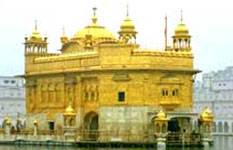
The Baisakhi and Diwali fairs in April and October every year are celebrated with great fervor and gusto.
On the fair of Baisakhi all the jewelry in the toshakhana (treasury) of the temple, which consist of indescribable ornaments, is displayed around Sri Guru Granth Sahib.
Diwali of Amritsar is out-of-the-world. The entire Golden Temple is illuminated with traditional lamps of different colours. The reflection of the temple in the shimmering water of the holy pool binds the eye, to the many-a-splendoured pageant. Fire works display by the traditional professionals recreates the glory of the times gone past.
Goindwal Sahib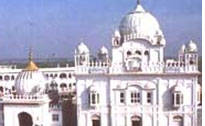
Within easy reach of Tarn Taran was the centre of Sikh religion during the time of the third Prophet, Guru Amar Das ji. The deep well (bauli) in the Gurudwara has 84 steps. Whoever takes a bath here and recites Japji Sahib (divine composition of the first Prophet of the Sikhs, Sri Guru Nanak Dev ji ) at each step, and repeats the recitation followed by bath in the Holy Well 84 times, attains moksh, because he lives out 84,000 cycles of birth representing each specie created by God.
Khadur Sahib
52 Kms from Amritsar. Commemorates the seat of Sikh religion during the time of the second Prophet, Guru Angad Dev Ji.
Baba Bakala
45 Kms from Amritsar. The 9th Prophet Guru Teg Bahadur had revealed himself to Makhan Shah Lubana, a Sikh devotee here. A fair is held here on the occasion of Rakhsha Bandhan.
Dera Baba Nanak
(35 Kms west of Gurdaspur) Guru Nanak Dev Ji spent last 12 years of his life here. Clothes he wore at Mecca are preserved here. A fair called the Maghi fair is held here every January.
Gurudwara Ber Sahib, Sultanpur Lodi
This is the Gurudwara built at the place where the first prophet Guru Nanak got enlightenment and created Sukhmani Sahib while taking bath in the river Kali Bein.From Sultanpur lodi only the Guru Nanak started his famous journeys. Sultanpur Lodi in Kapurthala district is easily accessible from Jalandhar and Amritsar via Taran Taran and Goindwal Sahib. One can plan his visit from both Amritsar( around 60 km away) and Jalandhar(36 km away).
Gurudwaras at Kiratpur Sahib (90 Kms from Chandigarh)
Kiratpur was established in 1627 by the 6th Prophet, Sri Guru Hargobind Ji. The place is associated with the memory of a Muslim Saint, Pir Buddan Shah who was gifted with a very long life.
Gurudwara Charan Kamal
commemorates the spot where the Pir had met the Ist Prophet of Sikhism, Sri Guru Nanak Dev Ji. His mausoleum is located on a hill nereby. He died after the 6thProphet had established Kiratpur.
Gurudwara Shish Mahal Sahib
The 6th Prophet had established his residence here. The 7th Prophet Sri Guru Har Rai Ji and the 8th Prophet Sri Guru Harkrishan Ji were born here.
Gurudwara Damadama Sahib
The 6th Prophet used to deliver divine sermons here.
Gurudwara Sri Takhat Sahib
The 6th and the 7th Prophets were proclaimed Gurus at this spot according to the Sikh tradition and rites.
Gurudwara Harmandir Sahib
The 6th Prophet had laid a herbal and flower garden here. Mohsin Fani, the famous scholar of Religions of his times and the Mughal Prince, Dara Shikoh had met Sri Guru Hargobind Ji here.
Gurudwara Manji Sahib
Marks the site where the 6th Prophet's daughter, Bibi Veero had got her house constructed. A sacramental book containing divine hymns (Pothi), a cot, a hand-fan and a scarf gifted to her by her father and the holy of cap of Guru Nanak Dev Ji can be seen here.
Gurudwara Babaan Garh
Bhai Jaita (Jiwan Singh after baptism), in defiance of the Mughal authority had managed to escape with the martyred head of the 9th Prophet,Sri Guru Teg Bahadur from Delhi after his martyrdom in 1675. It was first rested here. From Gurudwara TEER SAHIB the 6th Prophet had revealed Gurudwara Patal Puri by shooting an arrow. The 7th Prophet was created at Patal Puri and ashes of the 8th Prophet were immersed in river Satluj nearby. Gurudwara Baba GURDITTA is located on a close by hill. In 1665 the 9th Prophet Sri Guru Teg Bahadur had bought the site of Anandpur Sahib from the Rani of Bilaspur.
Gurudwaras at Anandpur Sahib
GURU-KA-MAHAL It was built as the residence of Guru Teg Bahadur ji. Sri Guru Gobind Singh Ji also stayed here and his four Sahibjadas (baby sons) were also born here.
Gurudwara Thara Sahib
It was at this spot in 1675 that a delegation of 15 Kashmiri Brahamans led by Pandit Kirpa Ram had come to beseech the 9th Prophet to save them from the tyranny of the Mughals who were forcibly converting them to Islam. It was here that the Prophet had decided to embrace martyrdom to awaken the dead soul of India that of the Mughal Emperor Aurangzeb.
Gurudwara Sis Ganj Sahib
The martyred head of Guru Teg Bahadur who embraced martyrdom in Delhi in 1675 to save Hindu dharm was brought from Kiratpur Sahib and cremated here.
Gurudwara Takhat Sri Keshgarh Sahib
The Panj Piaras five beloved ones) were baptised here ; Sikhs were consummated as the Khalsa -saint soldiers, at this spot. 12 weapons of the 10thProphet are preserved here. One among them is Hazrat Ali's sword. The Hola Mohalla fair of Anandpur Sahib is famous.
Gurudwara Damadama Sahib
Takhat Sri Damdama Sahib, Talwandi Sabo, Bhatinda, is the fifth seat of the authority of Sikhs. This place owes its importance to the literary work of Guru Gobind Singh Ji done here during his stay in 1706. It was at Damdama Sahib that Guru Gobind Singh Ji prepared the revised & authentic version of the Adi Granth, which is now being honored by the Sikhs as Guru Granth Sahib ji. He added to the original version prepared by Guru Arjan Dev Ji the verses of Guru Teg Bahadur Ji. A large number of new converts joined the fold of the Khalsa here. Guru Gobind Singh Ji stayed at Damdama Sahib for nearly a year.
After leaving the fort of Sri Anandpur Sahib & passing through Chamkur Sahib, Maachiwara, Deena Kangar followed by historic war of battle in Mukatsar. Guruji arrived in Talwandi Sabo in the Year 1705 on a high-elevated small piece land. On that place Guruji took a break & relaxed. Due to this reason this pious piece of land is famous as Damdama Sahib. From Damdama sahib Guruji released orders (Hukamnama) for Sikh Desciples & announced or rather declared this sacred place as a Takhat. According to Dr. Trump's writings in 1706 Guruji Baptised around 1.2 lac devotees on the occasion of Baisakhi's Get together (Jor Mela). Maintaining the same custom, every year Baisakhi's festival is celebrated in same way here & lacs of devotees come here to get Guruji's blessings even today.
Gurudwara Guru-ka-Lahore
(11 Kms from Anandpur Sahib) On 25th January,1686 the 10th Prophet was married to Mata Jito Ji here. Three springs of water which the 10th Prophet had lanced open from huge rocks are still flowing. Sandwiched between Sri Anandpur Sahib and Sri Kiratpur Sahib is CHAMKAUR SAHIB. It was in this area where , having sworn safe passage to the 10th Prophet's family and forces the Mughal and the hill Chiefs had treacherously attacked them. Gurudrawa Katal Garh Sahib commemorates the martyrdom of the two elder Sahibzadas and 37 Singhs who had died fighting here,Gurudrawa Pariwar Vichhora Sahib marks the site where the 10th Prophet's family got scattered. Gurudwaras GARHI SAHIB, TARRI SAHIB, RANJIT GARH SAHIB are connected with the dharm yudh that the 10th Prophet had waged against the tyrants.
Mosques masjids in punjab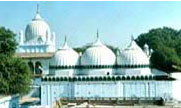
Mazaar, Pir Baba Haji Rattan, Bathinda City
Situated between the Civil Hospital and the grain Market. It attracts devotees from all faiths. Baba Haji Rattan had visited Mecca as an ambassador of Raja Bhoj. On returning to India he had settled at Bhatinda. The Mazaar ( mausoleum) marks the site where the Peer used to meditate. The place is halloed by the visits of the 1st and the 10th Prophets of Sikhism, Guru Nanak Dev Ji and Guru Gobind Singh Ji.
Rauza Sharif, Sirhind
Can be reached both from Patiala, 50 Kms north as well as from Chandigarh by road and by train. The magnificent and spacious Rauza is a mausoleum which commemorates the burial place of Mujadid-alf-Saani Sheikh Ahmed Farooqi, Kabuli, Sirhindi who lived during the reigns of Akbar and Jahangir from 1563 to 1634. The old mosque in the vicinity is extant, so are several cenotaphs. The tomb of the Shah Zaman, one of the Kings of Afghanistan indicates that the Rauza was once considered a propitious burial place of high and mighty. Some Muslim sects place it, next only to the Mecca in reverence. A great Urs is held here every August yearly.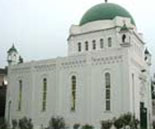
Qadian
Near Batala on Amritsar-Gurdaspur road. Little over one hour's drive from Amritsar can also be reached by rail. Qadian is the home of the Ahmediya sect of the Muslims founded by Sheikh Ahmed Qadiani towards the end of the 19th Century. Quadian is actually a town-ship with remarkable structures. The soaring Minar-i-Qadian, the Ahmediya mosque and tomb of the founder epitomise its soul. Ahemdiya flourishing all over the world congregate here in the last week of December.
The Moorish Mosque, Kapurthala City
Situated near the railway station it was built in 1930 during the reign of the last Maharaja of Kapurthala, Jagatjit Singh. He had employed a French architect Manteaux who followed the design of the great Qutbiya Mosque, at Marakesh in Moracco. The inner dome of the mosque was decorated with designs composed by the artists of the Mayo School of Arts, Lahore.
Imam Nasir Mausoleum and Jamma Masjid, Jalandhar City
The beautifully designed mausoleum of Imam Nasir and the Jama Masjid are both located in the heart of the Jalandhar city. According to archaeologists the former is 800 year and the latter 400 years old.
Chilla Baba Seikh Farid, Faridkot City
A small monument which commemorates the visit of the great saint Baba Farid. Baba Seikh Farid Shakarganj was famous as the Sufi Saint of Pakpattan, near Multan (now in Pakistan). On his way to Hansi and Delhi, the Baba had halted at this place for some time. The city of Faridkot is named after him. His divine couplets are included in the scripture of the Sikhs.
Devi Talab Mandir in Jalandhar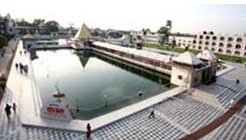
Devi Talab Mandir in Jalandhar is an ancient temple, which is, situated just 1 km from the railway station of the city. The temple is believed to be more than 200 years old. The old structure of the Devi Talab has been renovated and a number of new changes have been made. In the center of the temple premises a new temple has been recently constructed. In the temple premises very recently a model of Amarnath Yatra has been constructed.
Beside the Devi Talab of the Devi Talab Mandir lies an old temple of goddess Kali. The Hindus consider the temple sacred and large numbers of devotees visit the temple every year. One of the main attractions of the temple is an old tank, considered very holy by the Hindus and which has been believed to be constructed some 200 years ago. Devi Talab Mandir in Jalandhar is very famous for the 'Hariballabh Sangeet Sammelan’, which is celebrated every year in the month of December. This musical festival is being celebrated for the past 125 years in the Devi Ta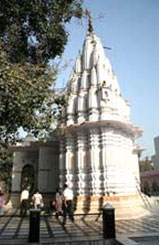 lab Mandir premises. Well known classical music proponents belonging to both the fields of instrumental and vocal participate in this festival and perform at this Hariballabh Sangeet Sammelan. lab Mandir premises. Well known classical music proponents belonging to both the fields of instrumental and vocal participate in this festival and perform at this Hariballabh Sangeet Sammelan.
Kali Devi Temple – Patiala
One of the consecrated place of worship for the Hindus, the "Kali Devi Temple, Patiala", is devoted to Goddess "Durga". Located on "Mall Road" of Patiala in Punjab, just in front of the "Baradari Garden", the huge monument of the "Kali Devi Temple" is an architectural wonder of the by gone days. Constructed by the royal family of Patiala, the splendid temple of "Kali Devi" is an important landmark of the ancient city. The "Kali Devi Temple" draws many devotees from far and near who visit the temple to seek divine blessings for eternal happiness. Far from the hustle bustle of the city, the calm surrounding of the holy temple provides relief and solace to mind and soul of the devotees. The "Kali Devi Temple" is a living witness to the traditional rituals and customs of the Hindu religion that has triggered down the ages to the modern industrial society of India. The temple rigorously adheres to all the age-old customs of Hinduism and inspires the devotees to do the same.
The sacred sanctorium of the "Kali Devi Temple" bears relics to the rich art and architecture of the ancient times. Apart from the splendid architectural edifice, the walls of the temple have beautiful mural paintings and sceneries that add to the grace of the monument, so much so that it has been adjudged as a "national monument". The colorful and attractive paintings on the walls draws tourist from far and near whom are completely overwhelmed at the beauty of the giant structure. The wonderful architectural creation coupled with an aesthetic appeal of the "Kali Devi Temple" is pretty awe inspiring for the tourist who throng the holy shrine in search of eternal happiness.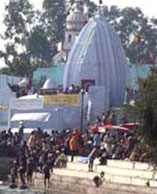
Ram Tirath Temple - Amritsar
Ram Tirath Temple is located at a distance of 11 kilometers West of Chogawan road, Amritsar. The Temple dates back top the period of Ramayana. There is an ancient tank at this place. A number of Temples are scattered in the area. At the site there is a hut where Mata Sita gave birth to Luv and Kush. The site also has Maharishi Valmiki's hermitage and a well with stairs where Mata Sita used to take her bath. The Temples exhibit scenes from Ramayana.
Even in the holy book of Hindus, The Ramayana, the place is mentioned. Sita Mata came here after Lord Rama deserted her and got shelter in Maharishi Valmiki's hermitage. Sage Valmiki trained the children of Lord Ram, Luv and Kush and made them proficient in all fields, be it warfare or religious / social eduction. Annual Fair is held in Ram Tirath in the month of November on the full moon day. The fair lasts for four days.
Durgiana Mandir - Amritsar
Shree Durgiana Mandir in Amritsar is a focal point of faith for the Hindus. Pilgrims flock to this temple not only from India but also from abroad. Over the years, it has become an epicenter of Hindu renaissance and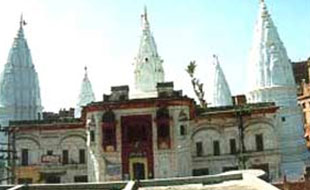 rejuvenation. The complex is popularly known as the Durgiana derives its name from the Goddess Durga. This connection with Goddess Durga has a socio cultural references as Goddess Durga is normally invoked for protection and health while the soldiers go to war. Placed strategically in the middle of the city, the mandir is very easily approachable by Rail, Road & Air. rejuvenation. The complex is popularly known as the Durgiana derives its name from the Goddess Durga. This connection with Goddess Durga has a socio cultural references as Goddess Durga is normally invoked for protection and health while the soldiers go to war. Placed strategically in the middle of the city, the mandir is very easily approachable by Rail, Road & Air.
The sacred city of the Amritsar, which was founded by the fourth Sikh Guru Ram Dass ji, has come to assume a special significance in Hindu cosmology because of various mythical and historical connections. Amritsar is particularly nearer and dearer to Hindus as it is believed that the Lov-Kush along with their mother Mata Sita spent their early childhood in the ashram of Bhagwan Maharishi Balmiki ji in the land of Amritsar.
Panch Mandir - Kapurthala
One of the most admired places, the "Panch Mandir, Kapurthala Town" is dedicated to several Hindu Gods and Goddesses. Constructed by "Fateh Singh Ahluwalia”, the "Panch Mandir" of the Kapurthala town in Punjab bears the relics of rich architectural legacy of the by gone golden era. The temple is an important hallmark of the small town of Kapurthala, which draws several devotees from all over the state to seek divine blessings. As the name suggests, the temple houses numerous small temples that are dedicated to different Gods and Goddesses. Many smaller temples encircle the giant structure at the middle of the holy sanctorium. The temple displays the engineering skills of the people of the ancient times. Apart from being an important place of religious worship, the "Panch Mandir" is also a celebrated place for archaeologists who throng the temple to study the rich architecture of the traditional society.
The beautiful white structure of the "Panch Mandir" looks strikingly awesome on a moonlit night. The sacred temple gives one an intense pleasure and satisfaction. The "Panch Mandir" may be said to be an architectural marvel of the golden past. One cannot but appreciate the splendid monument that has an aesthetic appeal for the devotees. The awe-inspiring structure of the "Panch Mandir" has its model in one of the museums of Lahore, now in Pakistan.
The "Panch Mandir" of the Kapurthala town is always full of devotees who visit the holy shrine in search of peace of mind and soul. The clean and well maintained surrounding of the temple is an epitome of "purity" and "eternal happiness".
Shiv Mandir - Jalandhar
One of the most ancient temples of the region, the "Shiv Mandir, Gur- Mandi, Jalandhar" represents the deep religious fervor of Punjab. Agricultural advanced and industrially developed state of Punjab, also nurtures an intense faith in the "Supreme Being". Being one of the most secular state of our country, Punjab portrays the rich religious and cultural tradition of the by gone golden era.
Located in the heart of a busy market of the "Gur- Mandi", the temple of Lord Shiva bears relics of the brilliant architectural ability of the ancient times. Constructed by a Muslim "Nawab" of the "Lodhi dynasty", adjacent to the mosque of Imam Nasar, the age old temple is a living witness of religious tolerance which has triggered down across the centuries to the modern period.
The famous temple of Lord Shiva highlights the engineering skills of the people of the by gone days. The temple presents a perfect blend of the Hindu and Muslim architecture. While the entrance to the sacred temple was modeled after the gate of a mosque, the other buildings of the temple bear a rich style of the Hindu architecture. Many devotees through out the year visit the temple. However, the holy shrine assumes special importance during "Shiv Ratri" and other Hindu festivals when devotees throng the place to seek divine blessings.
The temple of Lord Shiva is an important landmark of the ancient city of Jalandhar. Amidst the problems of religious intolerance and injustice, the Shiv Mandir of the Gur Mandi stands tall with its long and enriched history of secularism.
Gobindgarh Fort Amritsar, Punjab
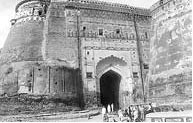 The fort occupied a unique place in the Indian military history. Built in 1760, it was called Bhangian Da Kila (Bhangis was one of the twelve Sikh misles). According to historians, during 1808, the fort was known as the fort of Gujjar Singh Bhangi. Later it was re-built by Maharaja Ranjit Singh with the help of Jodh Singh. The legendary Maharaja strengthened the fortification of the fort in order to keep his treasures and treaties in safety. The specially constructed Toshakhana, in the centre of the fort, also stored large amount of grains and provisions for the 12,000-strong army. The fort occupied a unique place in the Indian military history. Built in 1760, it was called Bhangian Da Kila (Bhangis was one of the twelve Sikh misles). According to historians, during 1808, the fort was known as the fort of Gujjar Singh Bhangi. Later it was re-built by Maharaja Ranjit Singh with the help of Jodh Singh. The legendary Maharaja strengthened the fortification of the fort in order to keep his treasures and treaties in safety. The specially constructed Toshakhana, in the centre of the fort, also stored large amount of grains and provisions for the 12,000-strong army.
The fort was constructed with brick and lime with numerous army bastions and iron gates with 25 cannons on the ramparts, now replaced with modern weaponry. The fort was constructed on a square pattern with a parameter of 1500 sq mt with two strong gates, four large bastions and well-defined rampart. The majestic entrance has been named Nalwa Gate, after the great Sikh warrior. The other end of the gate is known as Keelar Gate and it is rumoured that in its close proximity existed an escape tunnel, connecting to Lahore tunnel. However, the army authorities said that they had not been able to locate any such tunnel so far.
The British Army had added Darbar Hall, Hawa Mehal and Phansi Ghar (hanging place) to the fort after the annexation of Punjab. After Partition, the fort provided a temporary shelter to a large number of refugees from Pakistan. In October 1948, the fort was handed over to the Indian Army.This fort holds a special significance in the freedom struggle. It has been a witness to many nameless freedom fighters who kissed the gallows willingly. Gen O Dyer's office-cum-residence was located just opposite the Phansi Ghar. It is said that he got sadistic pleasure watching the hanging of the patriots in the Phansi Ghar.
Even the staunchest critics agree that the army had tried its best to keep the buildings in the fort intact. However, reservations are already being expressed whether the state government would be able to preserve (and restore) its original glory. A large number of city residents, who had lost their dear ones during summary trials under the British rule, have been trying to gather information about their relatives who were hanged to death in the Phansi Ghar.
Some of the freedom fighters had sought the permission of the government to build a suitable memorial at the Phansi Ghar, which had stood out as a place of resistance against the atrocities of the British military general, General O Dyer, the perpetrator of the massacre of Jallianwala Bagh in 1919. Fort Gobind Garh has been taken over by the Indian army and is now off limit.
Faridkot Fort, Punjab
According to the compiler of the Gazetter of Faridkot State (Lahore, 1914), the old fort was built by Raja Mokulsi on square-shaped land, measuring more than 10 acres. Around 1775, it was reconstructed by Raja Hamir Singh. The main building seen at present and other important structures were built around 1890 by Raja Bikram Singh (1842-1898) and by Raja Balbir Singh (1869-1906). Raja Bikram Singh, who ruled for 24 years, contributed a lot to Faridkot state. Raja Balbir Singh died in 1906 and was succeeded by Raja Barjinder Singh, who ruled up to 1918. The next and the last ruler of Faridkot state, Raja Sir Harinder Singh Brar Bans Bahadur, ascended the rajgaddi in 1918 after the death of Raja Barjinder Singh. On assuming power, he established many educational institutions and other important buildings in the town.
The beauty of this fort lies in its magnificent architecture. Elegantly designed in European style and constructed by skilled masons, it is a masterpiece of workmanship. Its floors, ceilings, walls and arched openings have been executed with artistic precision.
Fashioned out of small Nanakshahi bricks and lime mortar, more than 20-foot-high ramparts and large bastions (burjs) constructed for the security guards and to mount the guns are still safe and sound, thanks to the repairs carried out by the Maharawal Khewa Ji Trust, Faridkot. But the main building and other structures of the complex (except Sheesh Mahal and Moti Mahal) need massive repairs and restoration work.
The entrance to the fort is provided through a beautiful multi-storeyed deori. It has a 14-foot-wide and 22-foot-high heavy wooden gate, which was used as a protective shield during war. The splendid artistic pattern on the ceiling of the deori is praiseworthy and attracts visitors. On the first floor of the deori is the beautifully designed Sheesh Mahal or hall of mirrors. The concave and convex glasswork is quite romantic. Some beautiful paintings decorate the walls. The desire of Raja Sir Harinder Singh to have a large museum in Sheesh Mahal is yet to be fulfilled. To make the fort impressive, two big guns placed in the baradari welcome visitors to the fort. The main building and other structures of the fort have been constructed on a ground which is 12 feet above the main road and entrance gate, for safety reasons.
The huge building of Moti Mahal built to the south of the entrance, now houses the offices of the Maharawal Khewa Ji Trust (which looks after the properties of Raja Harinder Singh). Gurdwara Sahib and Modi Khana (military barracks) have been constructed to the north of the entrance. For the protection of the royal family from air attacks, an air-raid shelter was also built in the fort complex.
The 34-foot-wide, 90-foot-long and 22-foot-high Darbar Hall of the main building has been built in such a way that it remains cool even during the hot season. The architectural beauty of the Darbar Hall dazzles one and all. Although the false ceiling stands damaged at many places, the artistic work done on the false ceiling in plaster of Paris and woodwork executed on big arches of the Darbar Hall is unmatched. Carved wood panelling on the Darbar Hall walls and its marble flooring still look graceful. But artistically designed wooden chhajjas built around the main building on the first floor are unsafe. The fort building, except Sheesh Mahal and Moti Mahal which is vacant these days, was earlier used by the District Administration. It did not pay any rent for a long period even after the dissolution of the state.
The Archaeological Survey of India maintains around 3600 ancient buildings all over the country and 30 important historical buildings in Punjab, but it has not given protected status to Qila Mubarak. There are a number of historical buildings in Faridkot like the Civil Secretariat, Darbar Gunj, Clock Tower, Raj Mahal, Shahi Samadhan, Panchvati, Thakur Dwara, Gurudwara Godri Sahib and Tilla Baba Farid. If the town is developed as a tourist place, it could earn revenue.
According to available information, the repair and restoration work of the Darbar Hall is being entrusted to a Delhi-based company. The company has worked for UNESCO and other organisations. It will complete this gigantic task in 15 months and it will cost the trust approximately Rs 50 lakh in the first phase.
Aagman Purb of Baba Farid is celebrated every year from September 15 to 23 by the Faridkot District Cultural Society with great fun and fare. The Government of India has sanctioned national status to this Farid Mela. People from all walks of life participate in it. Devotees also pay obeisance on every Thursday at Tilla Baba Farid. History or civilisation of a town can be studied to a great extent through its temples and forts. The fort should be opened to public on such occasions and information boards carrying the history of the fort and town should be fixed inside and outside the fort for the knowledge of the public.
Summer Palace of Maharaja Ranjit Singh (1780-1838 AD), Amritsar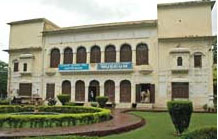
It was constructed under the supervision of Fakir Azeez-ud-din and Sardars Lehna Singh and Desa Singh Majithia, nobles of the Lahore Darbar at a cost of Nanak Shahi Rs. 1,25,000/- Originally, laid in a garden spreading across 84 acres of rare plants, trees and flowers, surrounded by a boundary wall, 14 feet high and a moat all around it, this beautiful palace had also several equally beautiful clusters of structure which were converted into clubs and libraries, the lawns around them into tennis courts by the British.
The entrance of the palace called the Darshani Deori is unique in design. It has four two storied towers in the cardinal directions. There are two tanks, the one connecting the palace with water channels fitted with fountains and the other with the air-conditioning pipes circuiting the outer walls and the bathing tanks of the double storied part of the residence. Some of the paintings and the mirror work on the roofs are still extant.
Quila Mubarak Patiala, Punjab
Patiala, a city of gardens and palaces, has a rich architectural and cultural heritage. The oldest part of Patiala is the walled city within which Quila Mubarak; the oldest fortified palace of the city, sits on a raised mound.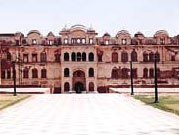
Quila Mubarak forms the core around which the walled city developed. It dates back to 1763 AD. Baba Ala Singh, who was the founder of the Patiala dynasty built a kachigarhi (mud fortress) and named it Quila Mubarak. Later, it was reconstructed in baked bricks. Maharaja Amar Singh (1765-1781 AD) completed the construction of the inner palace called the Quila Androon. Maharaja Sahib Singh (1781- 1813 AD), Maharaja Karam Singh (1813 AD - 1845 AD) Maharaja Narinder Singh (1845 AD to 1862) had also resided in this fort.
The Quila is spatially preceded by the Quila Chowk and encircled by three major commercial spines, the Gur Mandi, Bajaja Bazaar and Shah Nashin Bazaar. The Adalat Bazaar starts from the Quila and terminates at the Anardana Chowk.
The Quila Mubarak Complex comprises numerous buildings, namely the Quila Androon, Ran Basa, Darbar Hall, Jalau Khana, Sard Khana, Quila Mubarak Gateway and the boundary walls. The Quila Mubarak Gateway is the only entrance to the Quila Mubarak Complex; it leads into a large public space called the Quila Androon Chowk. It is from this space that the monumental scale of Quila Androon can be experienced. The Quila Mubarak Gate is rendered in red sandstone and carries the appearance of a rather permeable latticed structure due to its multiple arched openings. On the inner edge of the Quila Androon Chowk is the Androon Gateway leading into Quila Androon. This is a solid masonry gateway with stuccowork.
Bahadurgarh Fort Patiala, Punjab
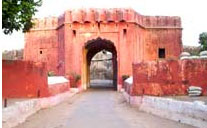 Bahadurgarh Fort 6 kms from Patiala originally founded by Nawab Saif Khan in 1658. Maharaja Karam Singh of Patiala built the present fort in 1837. It has two circular ramparts and is surrounded by a moat and covers an area of 2100 sq meters. This rather compact but nicely designed citadel is in the custody of the Department of police. Bahadurgarh Fort 6 kms from Patiala originally founded by Nawab Saif Khan in 1658. Maharaja Karam Singh of Patiala built the present fort in 1837. It has two circular ramparts and is surrounded by a moat and covers an area of 2100 sq meters. This rather compact but nicely designed citadel is in the custody of the Department of police.
The four wails of the fort enclose the village Saifabad located on the left side of the Rajpura-Patiala Road. Saif Khan, a relative of the Mughal Emperor Aurangzeb, after holding several important offices, became a hermit and settled down here. After his death he was buried here. His tomb behind the fort, a structure of 177 x 177 ft. is in a state of neglect. Notwithstanding this, his followers still lit a lamp on the tomb every Thursday.
The two inscriptions in the fort testify that the village and the mosque were founded in 1668 during the reign of Aurangzeb. As the custom goes, Nawab Saif Khan was a great admirer of Guru Teg Bahadur. He invited him to use rainy season here. His trip is commemorated by two gurdwaras- One inside the fort and the other outside across the road. It is well known as Maharaja Karam Singh constructed Panj Bali Gurdwara. The Bahadurgarh Fort throughout 1837-45 at a cost of Rs. 10, 00,000
Anandpur Sahib Fort, Ropar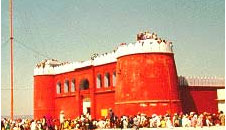
Anandpur Sahib Fort, Ropar. This was the first fort of Anandpur Sahib. Its foundation stone was laid on March 31, 1689. Guru Gobind Singh spent nearly 16 years in this fort, as it was strong and strategically located. The arms and ammunition of the Khalsa army were stored here. It was almost demolished by the army of Ajmer Chand in 1705. Several years later, the Sikhs built a gurdwara at the site of Anandgarh fort. Later S Jassa Singh Ahluwalia built a baoli (step well) here. A few walls of the fort existed on the northern side until 1985, but were removed to make room for a new building. The other fort walls were destroyed to make way for a circular road. Nevertheless, the gurdwara perched on a hill is an impressive sight. During the tri-centenary celebrations of the Khalsa Panth in 1999, a sound and light show depicting the history of the Sikhs in general and Anandpur Sahib in particular was held in this gurudwara every evening. This show commences each year during the Holla Mohalla and Baisakhi celebrations in March/April.
Phillaur Fort, Ludhiana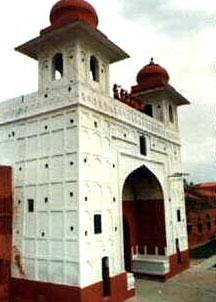
The Town of Phillaur in which this Fort is located owes its origin to a Sanghera Jat Phul called the town after him Phulnagar. Subsequently the Naru Rajputs under Rai Shahr whose territory extended from Mau to Selkiana occupied it & when his son Rai Rattan Pal abandoned Mau & settled at Phillaur. The Jats Left the modern town dates from the time of Shah Jahan (1627-1658 A.D.) when the sites covered with ruins reoccupied having been selected for the erection of a Serai on the imperial line of road from Delhi to Lahore, of its earlier history nothing of interest is recorded.
On the rise of the Sikhs to power, one Sudh Singh Kakara, who made it the capital of a considerable Estate, seized the place. His family became extinct in 1807 & the place then fell in to the hands of Maharaja Ranjit Singh who recognized its importance as a frontier town commanding the most frequented ferry of the Satluj. Under his governor Mohkam Chand a strong force was stationed at Phillaur from 1808 to 1812.
The Serai was converted in to a fort by the addition of a Fausse- Braye- Ditch & bastions a countermeasure to British occupation of Ludhiana Fort. The architect is said to have been an Italian engineer. When the Sikh garrison under S. Ranjodh Singh Majithia was withdrawn after the battle of Aliwal (January 28, 1848). Chaudhari Kutb-Ud-Din of Phillaur secured the keys of the Ford preserved them from Plunder & handed them over to Colonel Macheson & Brigadier Wheeler. When the British entered the Doab in the same year after the battle of Aliwal, a British cantonment was formed in the neighborhood of the Fort which continued to be occupied by native troops until 1857 when the detachment stationed there rebelled the Fort itself became an important artillery arsenal & magazine in 1883. The artillery & magazine were withdrawn from the Fort a detachment of native infantry was left as garrison in 1891. Even this detachment was withdrawn & the fort was handed over to the Police Department it is now occupied by Punjab Police Academy (formerly Police Training School established in January, 1892, it was raised to the status of a college in April 1967) & the Finger Print Bureau was established in August 1894 which has continued here since then.
|